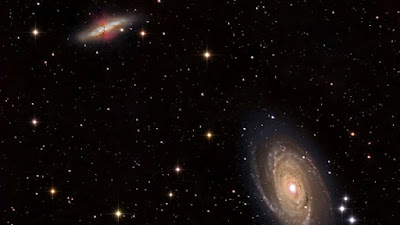 |
| A pair of nearby galaxies where "intergalactic transfer" may be happening. (Fred Herrmann) |
EVANSTON - In a first-of-its-kind analysis, Northwestern University astrophysicists have discovered that, contrary to previously standard lore, up to half of the matter in our Milky Way galaxy may come from distant galaxies. As a result, each one of us may be made in part from extragalactic matter.
Using supercomputer simulations, the research team found a major and unexpected new mode for how galaxies, including our own Milky Way, acquired their matter: intergalactic transfer. The simulations show that supernova explosions eject copious amounts of gas from galaxies, which causes atoms to be transported from one galaxy to another via powerful galactic winds. Intergalactic transfer is a newly identified phenomenon, which simulations indicate will be critical for understanding how galaxies evolve.
“Given how much of the matter out of which we formed may have come from other galaxies, we could consider ourselves space travelers or extragalactic immigrants,” said Daniel Anglés-Alcázar, a postdoctoral fellow in Northwestern’s astrophysics center, CIERA (Center for Interdisciplinary Exploration and Research in Astrophysics), who led the study. “It is likely that much of the Milky Way’s matter was in other galaxies before it was kicked out by a powerful wind, traveled across intergalactic space and eventually found its new home in the Milky Way.”
Milky Way’s origins are not what they seem, Megan Fellman, Northwestern University
Comments